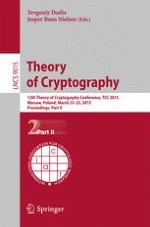The two-volume set LNCS 9014 and LNCS 9015 constitutes the refereed proceedings of the 12th International Conference on Theory of Cryptography, TCC 2015, held in Warsaw, Poland in March 2015.
The 52 revised full papers presented were carefully reviewed and
selected from 137 submissions. The papers are organized in topical
sections on foundations, symmetric key, multiparty computation,
concurrent and resettable security, non-malleable codes and tampering, privacy amplification, encryption an key exchange, pseudorandom functions and applications, proofs and verifiable computation, differential privacy, functional encryption, obfuscation.
